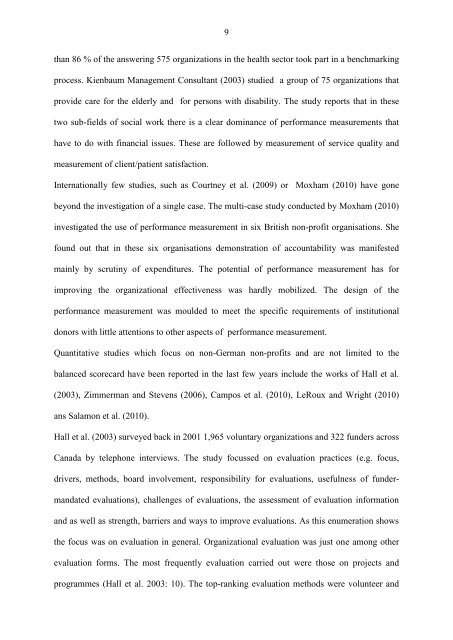Strategic responses to Performance Measurement in Nonprofit ...
Strategic responses to Performance Measurement in Nonprofit ...
Strategic responses to Performance Measurement in Nonprofit ...
You also want an ePaper? Increase the reach of your titles
YUMPU automatically turns print PDFs into web optimized ePapers that Google loves.
9<br />
than 86 % of the answer<strong>in</strong>g 575 organizations <strong>in</strong> the health sec<strong>to</strong>r <strong>to</strong>ok part <strong>in</strong> a benchmark<strong>in</strong>g<br />
process. Kienbaum Management Consultant (2003) studied a group of 75 organizations that<br />
provide care for the elderly and for persons with disability. The study reports that <strong>in</strong> these<br />
two sub-fields of social work there is a clear dom<strong>in</strong>ance of performance measurements that<br />
have <strong>to</strong> do with f<strong>in</strong>ancial issues. These are followed by measurement of service quality and<br />
measurement of client/patient satisfaction.<br />
Internationally few studies, such as Courtney et al. (2009) or Moxham (2010) have gone<br />
beyond the <strong>in</strong>vestigation of a s<strong>in</strong>gle case. The multi-case study conducted by Moxham (2010)<br />
<strong>in</strong>vestigated the use of performance measurement <strong>in</strong> six British non-profit organisations. She<br />
found out that <strong>in</strong> these six organisations demonstration of accountability was manifested<br />
ma<strong>in</strong>ly by scrut<strong>in</strong>y of expenditures. The potential of performance measurement has for<br />
improv<strong>in</strong>g the organizational effectiveness was hardly mobilized. The design of the<br />
performance measurement was moulded <strong>to</strong> meet the specific requirements of <strong>in</strong>stitutional<br />
donors with little attentions <strong>to</strong> other aspects of performance measurement.<br />
Quantitative studies which focus on non-German non-profits and are not limited <strong>to</strong> the<br />
balanced scorecard have been reported <strong>in</strong> the last few years <strong>in</strong>clude the works of Hall et al.<br />
(2003), Zimmerman and Stevens (2006), Campos et al. (2010), LeRoux and Wright (2010)<br />
ans Salamon et al. (2010).<br />
Hall et al. (2003) surveyed back <strong>in</strong> 2001 1,965 voluntary organizations and 322 funders across<br />
Canada by telephone <strong>in</strong>terviews. The study focussed on evaluation practices (e.g. focus,<br />
drivers, methods, board <strong>in</strong>volvement, responsibility for evaluations, usefulness of funder-<br />
mandated evaluations), challenges of evaluations, the assessment of evaluation <strong>in</strong>formation<br />
and as well as strength, barriers and ways <strong>to</strong> improve evaluations. As this enumeration shows<br />
the focus was on evaluation <strong>in</strong> general. Organizational evaluation was just one among other<br />
evaluation forms. The most frequently evaluation carried out were those on projects and<br />
programmes (Hall et al. 2003: 10). The <strong>to</strong>p-rank<strong>in</strong>g evaluation methods were volunteer and
















